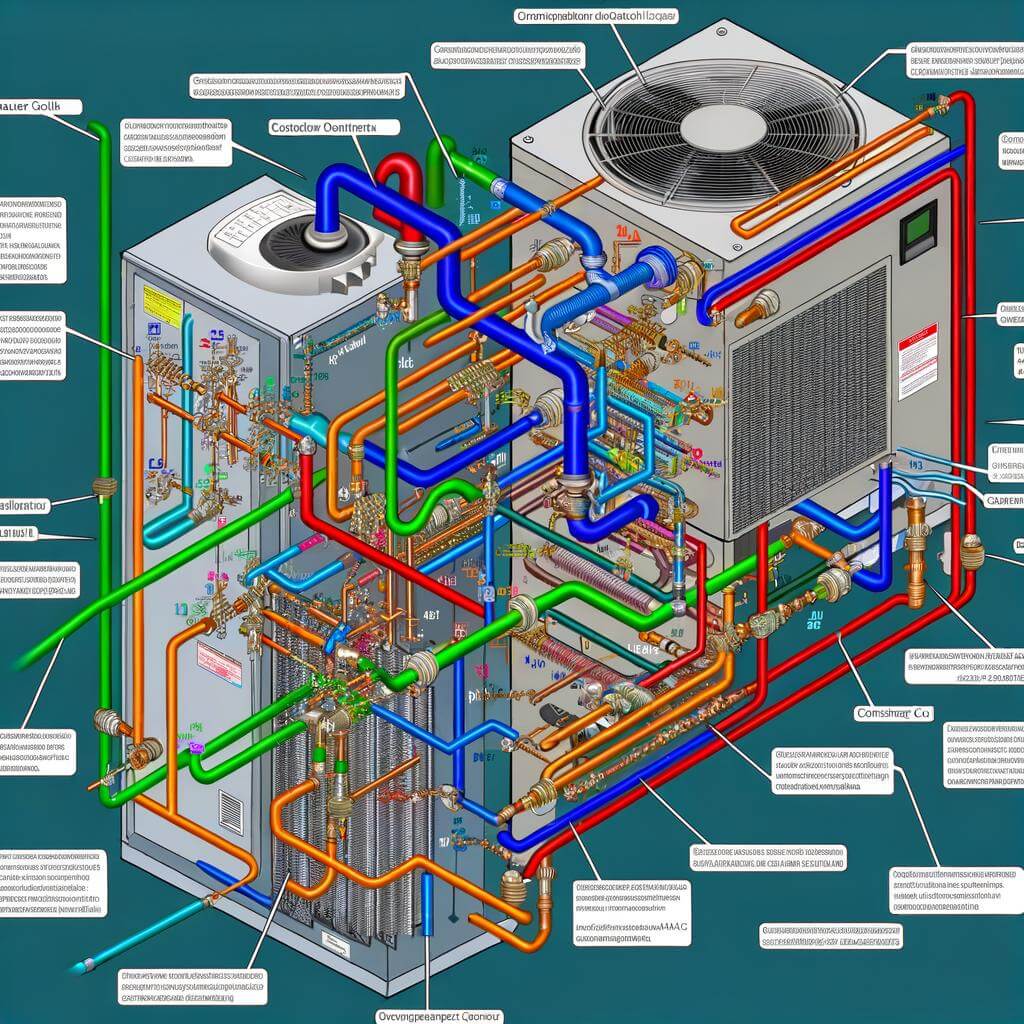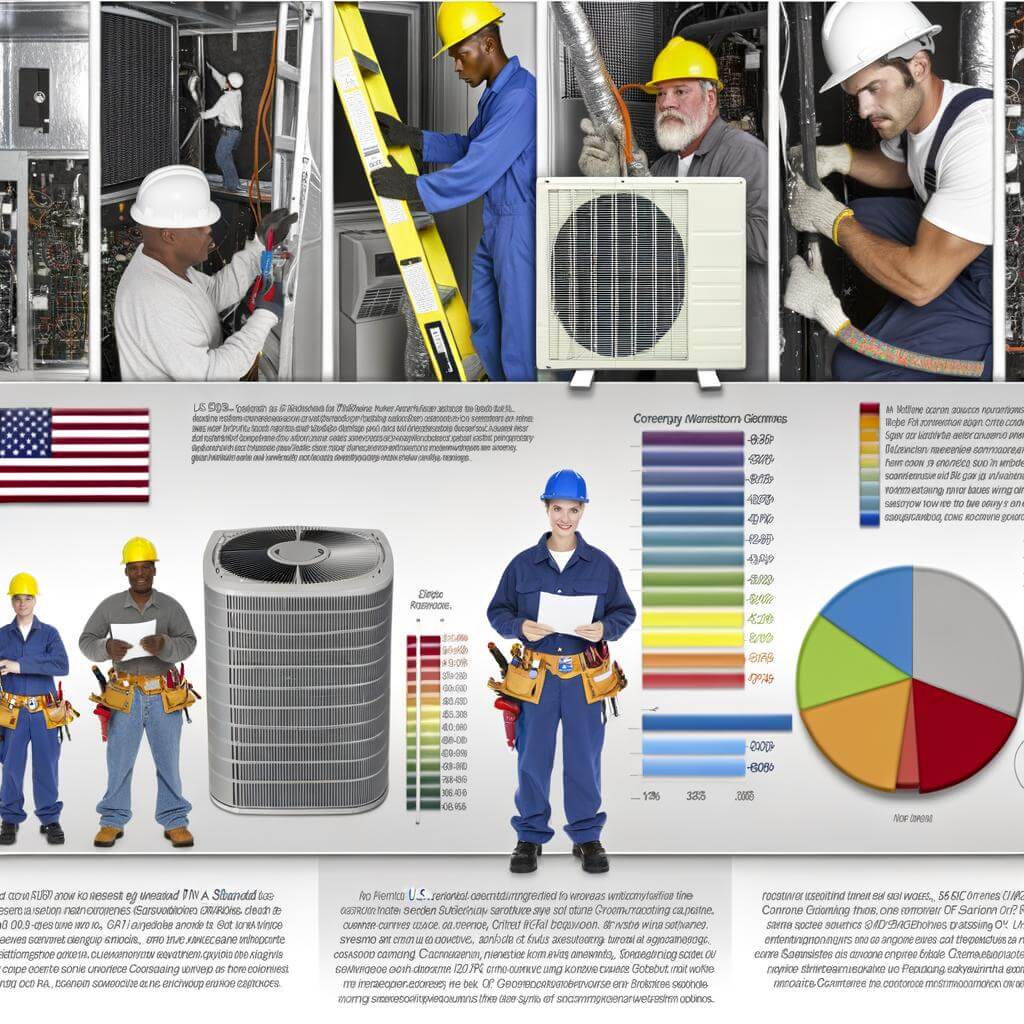Deep in the labyrinth of everyday living, unbeknownst to the average inhabitant, operates a system so ingeniously understated yet vital to the comfort balance of our dwellings and workspaces. This network of conditioned air delicately cradles us, oblivious mortals, in its comforting grasp all year round, preventing sweat beads in summer, and keeping frostbite at bay in winter. This system bears a mysterious name, HVAC, an acronym as paradoxically cryptic as it is ubiquitous. Today, we drift away from the path of ignorance and embark on an enlightening exploration into the depth of HVAC – Heating, Ventilation, and Air Conditioning, unwinding the twisted coils of its conception and tracing the evolutionary arc towards its current status as a U.S. standard. Brace for a voyage into the conduits of thermal comfort as we embark on decoding HVAC.
Understanding the Origins of the HVAC System: A Primer
Before the advent of the modern HVAC system, temperature regulation was a massive challenge. The inception of the HVAC (Heating, Ventilation, and Air Conditioning) system is often traced back to the Industrial Revolution. During this era, the industries required an efficient process to manage temperatures, leading to the invention of the steam heating system. More effective heating mechanisms continued evolving with advanced venting systems replacing rudimentary open fires and wood-burning stoves. These novel developments culminated in the production of the first commercial HVAC system in the early 20th century.
The progression and expansion of the HVAC system in America would not have been possible without the substantial contributions of a handful of innovative minds. For instance, in 1902, Willis Carrier, also known as “The Father of Air Conditioning,” developed a system targeting humidity control for a printing company. Shortly after, in 1906, Stuart W. Cramer coined the term ‘air conditioning’ after implementing water spray technologies to manage humidity levels in textile mills. The table below summarizes these notable figures and their contributions:
| Figure | Contribution |
|---|---|
| Willis Carrier | Developed the first system for humidity control |
| Stuart W. Cramer | Coined ‘air conditioning’ and introduced water spray technologies |
Nudged by these industrial legends, HVAC technology gradually evolved to become more consumer-oriented. This progression highlighted the importance of temperature control in residential buildings, leading to a boom in the production and installation of HVAC systems in homes throughout America. As the technology continued to advance, a new era began, marked by the advent of energy efficient HVAC systems, programmable thermostats, and the incorporation of green technology. There’s no doubt that the HVAC system’s origins are deeply rooted in American history, shaping our current standard of living and comfort.

The Building Blocks of HVAC: From Concept to U.S. Standard
Decoding the HVAC system begins with understanding its primary components: furnace, air conditioner, ductwork, and thermostats. The furnace represents the heart of the system, producing heat via combustion of natural gas, oil, or electricity. The air conditioner primarily cools the air, and its function involves a complex cycle involving refrigerants. It’s this cooled air that gets distributed through your property. Playing the role of the vascular system within this analogy, the ductwork encompasses the arteries and veins, circulating cooled or heated air across spaces. Last but not least, thermostats act as the command center regulating and maintaining the desired temperature.
Eventually, these concepts condense into U.S. HVAC standards, which serve as the criteria for designing, manufacturing, and installing HVAC systems. The standards are broadly divided into two: Performance Standards and Safety Standards.
| Performance Standards | Safety Standards |
|---|---|
| These standards primarily focus on the system’s effectiveness, energy-efficiency, and design. | Safety standards maintain the focus on areas such as risk of fire, electrical shocks, and toxic coolant leaks. |
A household of the U.S. could not install an HVAC system that does not meet these standards, thus ensuring quality, safety, and energy efficiency throughout the nation. As the understanding of atmospheric science and energy conservation evolves, so do these standards, reflecting the state-of-the-art in HVAC technology.

Tracing the Evolution of HVAC: The American Journey
The complex world of Heating, Ventilation, and Air Conditioning (HVAC) as we know it today didn’t spring up overnight. American resilience and ingenuity have been key in crafting the standards and methods we currently rely on for our comfort and health. In the novel ’30s and ’40s, the initial forms of what we now call HVAC systems began to emerge, when the focus was primarily on heating. These rudimentary systems often involved wood or coal-burning stoves, alongside radiator systems for impactful heat distribution.
Come the ’50s and ’60s, a significant shift occurred – the advent of residential and commercial air conditioning. Even within this revolutionary time, there were distinct phases of progression:
- The early ’50s: saw the creation of window air conditioning units, a stark leap from the heat-only solutions of the era before.
- Moving through the ’60s: central air conditioning systems started proliferating—offering businesses and homes a multifaceted solution encompassing both heating and cooling.
| Decades | Major Advancements |
|---|---|
| 1930s and 40s | Wood or coal burning stoves, Radiation systems |
| Early 1950s | Window air conditioning units |
| Late 1960s | Central air conditioning systems |
These key inventions and subsequent refinements throughout the past century have led to our present-day HVAC systems—offering sophisticated climate control options that are increasingly energy efficient, smartly automated and environmentally friendly. The clear narrative through the American journey of HVAC evolution? A resolute focus on creating comfort and promoting health, cleverly harnessing technology to meet these perennial human needs.

The Intricacies of HVAC System: Unveiling the Technical Aspects
Unpacking the world of heating, ventilation, and air conditioning (HVAC), we delve into the multifaceted technical details that culminate in the creation of this essential system. While many perceive HVAC as a mere mechanical setup designed for maintaining temperature levels, its workings involve sophisticated engineering techniques and intricate technology. Developed from the need for efficient thermal control, especially in expansive commercial buildings and residences, the HVAC system has become a predominant feature of infrastructural design in the U.S.
At the core of every HVAC system, there are a few key elements that are pivotal in its functioning. An extensive network of ductwork serves as the transit system for heated or cooled air, while the furnace generates the heat needed in colder months. Air conditioners, with their evaporator and condenser coils, are responsible for reducing the indoor temperature by removing heat from the indoor space.
- The thermostat is the control unit that allows us to dictate the desired climate.
- The ductwork is the conduits for the passage of air.
- The ventilators introduce fresh air and remove stale air, aiding in air circulation and maintaining indoor air quality.
Each of these components plays a significant role and contributes to the HVAC system’s overall effectiveness.
| Components | Main Functions |
|---|---|
| Furnace | Heats up air |
| Air Conditioner | Cools down air |
| Thermostat | Controls room temperature |
| Ductwork | Passage of air |
| Ventilators | Improves air circulation |
Understanding these technical aspects not only enhances our appreciation of HVAC systems but also helps us utilize them more efficiently and maintain them aptly. So, the next time you enjoy the soothing comfort brought on by your HVAC system, try to envision the complex technology that’s working tirelessly to create that perfect environment!

Lessons from the HVAC Evolution: Recommendations for the Future
Throughout the evolution of the HVAC system, there have been plenty of lessons learned. Going forward, there are key recommendations and best practices that can be adopted for better efficiency and cost-effectiveness. The changes observed in this field are outstanding. Older models were not only expensive to run but often needed frequent repairs. Modern systems have improved on this – but there is still a long way to go.
Key Future Recommendations:
- Improved Efficiency: While the current systems are much more efficient than their predecessors, there is still room for improvement. Manufacturers can focus on energy conservation to reduce operational costs for the users.
- Advanced Features: Incorporating advanced technological features, such as smart thermostats and zoning capability, can improve the user experience and control over the HVAC system.
- Go Green: With climate change a pressing issue, HVAC systems need to be eco-friendly. This includes using refrigerants that have zero ozone-depletion potential and a low global warming potential.
The following table provides a brief outlook on the evolution of the HVAC system, the problems faced in each stage, and general recommendations for future improvements.
| HVAC Evolution Stage | Problems Faced | Future Recommendations |
|---|---|---|
| Early Models | High operational costs and frequent repairs | Enhanced efficiency, |
| Modern Systems | Costly repairs, inadequate control over temperature settings | Smart features like zoning capability |
| Future Prospects | Potential impacts on climate change | Eco-friendly designs with low-impact refrigerants |

The Impact of HVAC Standards on the U.S. Heating and Cooling Industry
In the realm of heating and cooling, the standardized HVAC (Heating, Ventilating, and Air Conditioning) system is a term that conjures up undeniable significance. But what impact does its standardization precisely have on the U.S HVAC industry? Well, the answer is not just single-fold. The industry is invariably influenced at multiple touchpoints – from design efficiency, operational performance to regulatory compliance, and garnering customer satisfaction. Past decades have seen HVAC standards enforcing a concrete impact on the U.S. heating and cooling industry. In the design spectrum, manufacturers are driven to constantly enhance their products’ efficiency. This brought us to a juncture where a significant decrease has been noted in the energy required to operate HVAC systems. The mere fact of defining and improving upon targets of energy efficiency has led to the production of advanced machinery, a leap from the energy-guzzling systems of the yesteryears. In addition, the overall expansion of regulatory requirements has also intensified the demand for certified HVAC professionals, stimulating growth in another sub-sector of the industry.
| Impacts | Benefits |
| Design Efficiency | Energy saving |
| Operational Performance | Increase in lifespan |
| Regulatory Compliance | Environment friendly |
| Customer Satisfaction | Quality of service |
When it comes to the operational performance, HVAC standards haven’t disappointed either. The industry-focused emphasis on performance metrics only means the manufacturers now commit to increased longevity, reliability, and general performance of their HVAC equipment, making them more appealing to customers. Lastly, in terms of customer satisfaction, the uniform testing and performance standards aid in assuring customers of the quality they can expect, further enhancing industry credibility. Clearly, the trajectory of HVAC standards establishment and their ensuing impact has revolutionized the U.S. HVAC industry, and the implication of this is far-reaching. As we draw the curtains in our enthralling journey through the labyrinth of the HVAC system, we realize that the Genesis is more than a tale of technological evolution. It’s the story of comfort transformed into a standard, of needs sculpted into ingenuity, of shifts in lifestyle dictating changes in design…and ultimately a tale of civilization courting science to vent out discomfort in the most human way possible. In decoding HVAC, we have traversed time, swirled in regulations, maneuvered through the qualities of air, and contemplated the echoes of history. As we leave you in the warmth of clarity and the chill of understanding, remember that every temperature adjustment is an ode to this magnificent evolution. In the unseen labyrinth of ducts and wires, lies the heart of a machine that runs on human persistence and brilliance. Until next time, stay in your comfort zone!




